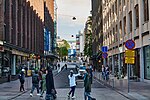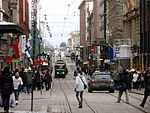Nasdaq Helsinki
1912 establishments in FinlandBuildings and structures in HelsinkiEconomy of FinlandEconomy of HelsinkiFinancial services companies established in 1912 ... and 5 more
Financial services companies of FinlandKluuviNasdaq NordicNasdaq exchangesStock exchanges in Europe

The Nasdaq Helsinki, formerly known as the Helsinki Stock Exchange (Finnish: Helsingin Pörssi, Swedish: Helsingforsbörsen), is a stock exchange located in Helsinki, Finland. Since 3 September 2003, it has been part of Nasdaq Nordic (previously called OMX). After the OMX merger, it was referred to as OMX Helsinki (OMXH), then after NASDAQ's acquisition of OMX in February 2008, NASDAQ OMX Helsinki, and currently Nasdaq Helsinki.
Excerpt from the Wikipedia article Nasdaq Helsinki (License: CC BY-SA 3.0, Authors, Images).Nasdaq Helsinki
Fabianinkatu, Helsinki Kaisaniemi (Southern major district)
Geographical coordinates (GPS) Address Nearby Places Show on map
Geographical coordinates (GPS)
| Latitude | Longitude |
|---|---|
| N 60.1684 ° | E 24.9492 ° |
Address
Pörssitalo
Fabianinkatu
00130 Helsinki, Kaisaniemi (Southern major district)
Finland
Open on Google Maps









